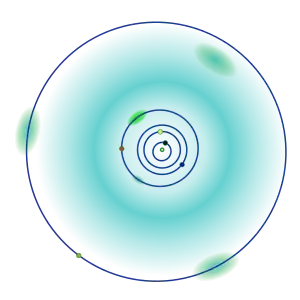| Discovery | |
|---|---|
| Discovered by | Alianza S4 |
| Discovery site | Cerro Burek |
| Discovery date | 21 September 2011 |
| Designations | |
| 2011 SL25 | |
Martian L5  | |
| Orbital characteristics[1] | |
| Epoch 13 January 2016 (JD 2457400.5) | |
| Uncertainty parameter 2 | |
| Observation arc | 1637 days (4.48 yr) |
| Aphelion | 1.698231 AU (254.0517 Gm) |
| Perihelion | 1.349540 AU (201.8883 Gm) |
| 1.523885 AU (227.9700 Gm) | |
| Eccentricity | 0.114409 |
| 1.88 yr (687.11 d) | |
| 55.63918° | |
| 0° 31m 26.159s /day | |
| Inclination | 21.49603° |
| 9.413048° | |
| 53.31859° | |
| Earth MOID | 0.396438 AU (59.3063 Gm) |
| Jupiter MOID | 3.52931 AU (527.977 Gm) |
| Physical characteristics | |
Mean diameter | 550±230 m |
| 0.5-0.05 (assumed) | |
| 19.4 | |
2011 SL25, also written as 2011 SL25, is an asteroid and Mars trojan candidate that shares the orbit of the planet Mars at its L5 point.[2]
Discovery, orbit and physical properties
2011 SL25 was discovered on 21 September 2011 at the Alianza S4 Observatory (I08) on Cerro Burek in Argentina[3] and classified as Mars-crosser by the Minor Planet Center. It follows a relatively eccentric orbit (0.11) with a semi-major axis of 1.52 AU.[3] This object has noticeable orbital inclination (21.5°).[3] Its orbit was initially poorly constrained, with only 76 observations over 42 days, but was recovered in January 2014.[1] 2011 SL25 has an absolute magnitude of 19.5 which gives a characteristic diameter of 575 m.[1]
Mars trojan and orbital evolution
Recent calculations indicate that it is a stable L5 Mars Trojan with a libration period of 1400 yr and an amplitude of 18°.[2][4] values as well as its short-term orbital evolution are similar to those of 5261 Eureka.[5][6]
Origin
Long-term numerical integrations show that its orbit is stable on Gyr time-scales (1 Gyr = 1 billion years). It appears to be stable at least for 4.5 Gyr but its current orbit indicates that it has not been a dynamical companion to Mars for the entire history of the Solar System.[2]
See also
References
- 1 2 3 "JPL Small-Body Database Browser: (2011 SL25)". Jet Propulsion Laboratory. Retrieved 31 March 2016.
- 1 2 3 de la Fuente Marcos, C.; de la Fuente Marcos, R. (April 2013). "Three new stable L5 Mars Trojans". Monthly Notices of the Royal Astronomical Society: Letters. 432 (1): L31–L35. arXiv:1303.0124. Bibcode:2013MNRAS.432L..31D. doi:10.1093/mnrasl/slt028. S2CID 118693165.
- 1 2 3 MPC data on 2011 SL25
- ↑ Christou, A. A. (2013). "Orbital clustering of Martian Trojans: An asteroid family in the inner solar system?". Icarus. 224 (1): 144–153. arXiv:1303.0420. Bibcode:2013Icar..224..144C. doi:10.1016/j.icarus.2013.02.013. S2CID 119186791.
- ↑ Christou, Apostolos A.; Borisov, Galin; Dell'Oro, Aldo; Cellino, Alberto; Devogèle, Maxime (January 2021). "Composition and origin of L5 Trojan asteroids of Mars: Insights from spectroscopy". Icarus. 354 (1): 113994 (22 pages). arXiv:2010.10947. Bibcode:2021Icar..35413994C. doi:10.1016/j.icarus.2020.113994. S2CID 224814529.
- ↑ de la Fuente Marcos, Carlos; de la Fuente Marcos, Raúl (March 2021). "Using Mars co-orbitals to estimate the importance of rotation-induced YORP break-up events in Earth co-orbital space". Monthly Notices of the Royal Astronomical Society. 501 (4): 6007–6025. arXiv:2101.02563. Bibcode:2021MNRAS.501.6007D. doi:10.1093/mnras/stab062. ISSN 0035-8711.
- Further reading
- Three new stable L5 Mars Trojans de la Fuente Marcos, C., de la Fuente Marcos, R. 2013, Monthly Notices of the Royal Astronomical Society: Letters, Vol. 432, Issue 1, pp. 31–35.
- Orbital clustering of Martian Trojans: An asteroid family in the inner solar system? Christou, A. A. 2013, Icarus, Vol. 224, Issue 1, pp. 144–153.
External links
- 2011 SL25 data at MPC.
- 2011 SL25 at AstDyS-2, Asteroids—Dynamic Site
- 2011 SL25 at ESA–space situational awareness
- 2011 SL25 at the JPL Small-Body Database